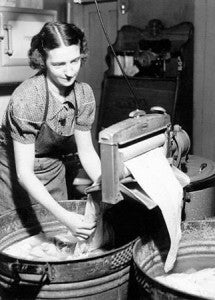
Dirty Lowdown: Why (and How) I Clean Everything
When I bought this dress from a friendly and reputable Etsy seller it looked perfectly clean, with only a slightly dusty aroma. No one would have suggested it was dirty. Here's one of the seller's original listing photos. So pretty:

But whether a garment is heading to my shop or into my own closet, it gets cleaned. Why? Several reasons.
1. Perspiration, skin cells, and food residue speed the decomposition of natural fibers. Even if you remain completely still (and I'm prone to dancing), you cannot wear your clothes without leaving a bit of yourself behind. Sweat alters dyes and breaks down natural fibers including silk, cotton, linen, and wool, as well as acetate and rayon (which are synthesized from natural fibers). Wash or dry-clean your clothes regularly. Washing is gentler, but anything lined, most rayon items, and anything labeled Dry Clean Only must* be dry-cleaned.

2. Dirt attracts vermin. Here in the Southeast, where bugs can thrive year round, extra vigilance is required to keep away clothes-loving insects, including the larvae of moths and worse, of carpet beetles, which eat absolutely everything except polyester! And while lavender may be sufficient in northern climes, to keep my stock safe without endangering people or planet, I use odor-free permethrin and dichlorvos (as and where appropriate).

3. Even if you don't see any bugs, eggs could be lurking in that wool sweater or hat, or fur-trimmed item. If so, you could wind up with an infestation and a lot of hole-riddled clothes. If you cannot dry-clean or wash an item, use the "Museum Method" to kill off any unwanted guests. Place the item in a zip-lock bag and stick it in the freezer (below 0°F/-18°C) for 24 hours, thaw for 24 hours, and repeat this cycle at least 3 times.

4. Mildew is contagious. Yes, really. Hang that stinky, uncleaned vintage dress in your closet (or stock room), and before too long, everything else will be speckled, smelly, and cause allergic reactions, too. Dry-cleaning might or might not kill mildew on the first go-around. If you can machine wash**, do. If odor lingers after a regular wash at the hottest advisable temperature, wash again with several cups of cheap vodka, then again with detergent. Some swear by ammonia, but I can't tolerate the smell (and you can't use the leftovers for cocktails).

For the cotton lawn dress, which was simply very old and in need of a good soaking, I turned to extra-gentle ORVUS quilt soap and just a bit of OxiClean:

Here's the water moments after adding the dress. That's some strong "vintage tea" brewing, and it shows you just how much dirt can be trapped in the fibers of a seemingly clean dress:
After two rounds of soaking and rinsing, I gave the dress a final wash in extra-gentle hand-washing detergent (my favorite is the Dollar General store brand in the pink and white bottle). Here's the final rinse:

And here's the dress about to be rolled in a towel then laid flat to dry on mesh racks:

The outward differences were very slight. It looked a bit brighter and smelled fresher. But of course it's what's inside (or not, in this case) that counts. Without its accumulated dust, the dress is more likely to survive another hundred years.
Each time I went to list this dress, the thought of it selling made me sad and I reconsidered. For now, it remains in my personal collection. In the photo below I'm wearing it for a scene in an independent film by a local director. For more on my involvement in the Atlanta film industry, click here (blog post about being a movie extra) and here (running list, with photos, of every production I've been part of).


Our thanks to the lovely Jennifer Rowland of Eado Vintage for granting us permission to use her photo(s).
* Insider Secret: If clothing is labeled Dry Clean, without the word Only, you can wash and press it yourself. Just be very careful (and avoid tumble drying).
** For non-washables (purses, shoes, etc.), I've found the best option is a thorough wiping down with a sanitizing towelette, then setting the item in direct sunlight for several days. Some dry-cleaners have special oxygen chambers that may be able to "zap" your item clean. In the end, however, mildew sometimes wins.

Comments
Nice to see the fruit of your labour…you are so right about it helping the fabric last longer. I have seen this so often even with wools, cottons and silks…they just feel and look so much better. It brings them back to life!
poppysvintageclothing.com
It was nice to read about your cleaning process, thanks for the well informed info!
Vodka? Well, who knew? Thank you for sharing the process. Lovely dress.

